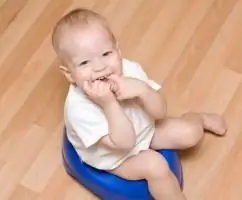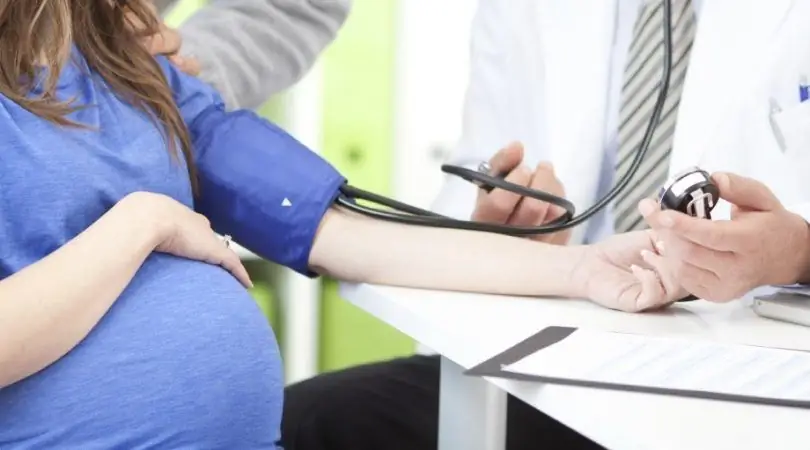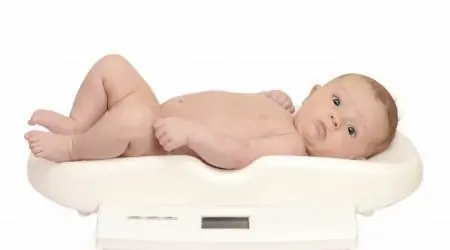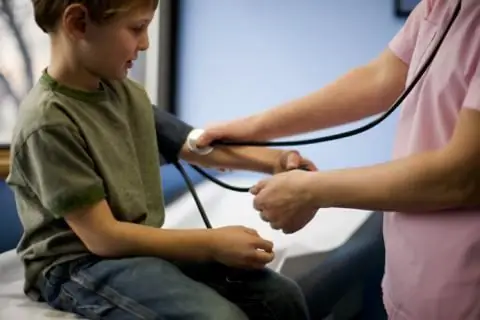2025 Author: Priscilla Miln | [email protected]. Last modified: 2025-01-22 17:55:16
It is a mistake to think that problems with blood pressure are the business of the elderly. Absolutely not! This disease can also affect the child. What should be the pressure in children? And is it very different from the norm of an adult?

The problem with blood pressure in children is much more common than you might think. And in order to prevent serious consequences in the future, it is extremely important to monitor the child's condition and periodically measure his pressure.
It should be said that the measurement results often differ from those of adults. Normal blood pressure in children is an order of magnitude lower, so it is categorically wrong to evaluate it by the same standards.
What affects blood pressure?
Little children have good elasticity of the vascular wall, a larger lumen of the vessel and better branching of the capillary network. All this directly affects blood pressure. In small children it is lower. Gradually, with age, it grows and reaches the norm of an adult.

The fastest increase in pressure in a child occurs in the first year of his life. By the age of five, the blood pressure of boys and girls is compared in terms of indicators, and then until the age of nine, it rises in boys.
Norm blood pressure in children
A newborn baby will have an average blood pressure of 80/50 mmHg
In order not to be tricky with formulas and not to count, a special table was compiled in which the pressure of the child is painted by age.
| Age of child | Blood pressure (BP), mmHg | |||
| Systolic pressure | Diastolic pressure | |||
| maximum score | minimum rate | maximum score | minimum rate | |
| Children from birth to 2 weeks. | 96 | 60 | 50 | 40 |
| 2 to 4 weeks | 112 | 80 | 74 | 40 |
| from 2 to 12 months | 112 | 90 | 74 | 50 |
| 2 to 3 years old | 112 | 100 | 74 | 60 |
| 3 to 5 years | 116 | 100 | 76 | 60 |
| 6 to 9 kids | 122 | 100 | 78 | 60 |
| 10 to 12 years old | 126 | 110 | 82 | 70 |
| from 13 to 15years | 136 | 110 | 86 | 70 |
Features of blood pressure of different ages
What should be the pressure in children from birth to a year?

In such crumbs, blood pressure depends on elasticity, lumen of blood vessels, development of the capillary network. Vascular tone is reduced - pressure is reduced accordingly. In a newborn baby, the indicators fluctuate within such limits - 60-96 / 40-50 mm Hg. By the year, blood pressure gradually increases, this is due to a rapid increase in vascular tone. And by 12 months it is 90-112 / 50-74 mm Hg
Mommies can use a special formula to determine the blood pressure of a child:
(76+2X), where X is the number of months for the baby.
What is the norm for such an indicator as blood pressure by age? The table above clearly demonstrates this information. It will not be difficult to determine the normal indicators for a particular child.
What should be the pressure in children from 2 to 3 years? After 2 years, the increase in blood pressure slows down somewhat, the table shows that it should be about 100-112/60-74 mmHg
It is possible a single increase in pressure, which is not a pathology, so you should not worry about this. But in any case, it will not hurt to consult a doctor once again - vigilance is above all.
For babies of this age there is a different formula: for systolic - (90 + 2X), for diastolic - (60X), where X is the numberyears old child.
What should be the pressure in children from 3 to 5 years old?

At this age, there is also a slow increase in blood pressure. It can be within the following limits: 110-116 / 60-76 mm Hg. It is also possible daily decrease and increase in pressure, which is physiological, that is, normal.
What should be the pressure in children from 6 to 9 years old? In principle, it remains at the same level and is 100-122/60-78 mmHg
At this time, there may be a deviation from the average. This is due to the fact that the child goes to school, his regime is rebuilt, the physical load on the child's body decreases, and the psychological load increases.
During this period, you should monitor the baby, and in case of frequent changes in pressure, consult a doctor.
What should be the pressure in children aged 10, 11 and 12?
The average values of the table are 110-126 / 70-82 mm Hg, but at this time puberty usually sets in, which can also affect blood pressure.

The child's physique also plays a role. Naturally, for thin and tall children, the indicators will differ from those of those who are shorter and heavier.
Therefore, it is better to consult a doctor and determine the average pressure of your child.
What should be the pressure in children from 13 to 15 years old? The table says that the average blood pressure is 110-136 / 70-86 mm Hg. But adolescence is quite difficult, children during this period experiencea lot of stress, difficult situations for yourself. All this affects he alth, and phenomena such as teenage hypo- or hypertension are possible.
During this period, in order to eliminate problems in the future, it is advisable to consult a doctor on this issue.
If a child has frequent headaches, then you should pay attention to this and go to the doctor. Most likely, he will ask to measure the pressure of the child. How to do it right?
Measure the correct pressure to the child
To begin with, we calm the baby, explain that we will not do anything bad to him, so that he relaxes and does not worry, as this can interfere.
It is extremely important to use a baby cuff, these are commercially available. There are also many good electronic blood pressure monitors in pharmacies.
It is better to measure blood pressure, of course, in the morning, when the child has just woken up, and in the evening, before going to bed. The child should lie on his back, ask him to take the pen to the side, palm up. It is important that the hand lies, and is not on weight.
Next, we find the elbow bend, put on the cuff a couple of centimeters above it. Then we check that the cuff does not pinch the hand too much, for this we put our finger under it, if it freely enters, then everything is fine.
Then we put the phonendoscope in a place where the pulse is well heard by touch, this is the cubital fossa. Next, close the valve, pump air until the pulse disappears. We slightly open the valve so that the air slowly descends, and carefully look at the scale.
The very first sound we hear speaks ofsystolic pressure, the last one is about diastolic.
The readings of each measurement must be recorded so that they can be shown at the next doctor's appointment.
Causes of high blood pressure in a child
High blood pressure in a child can occur for many reasons. More often this violation occurs in adolescent children, when not only physical, but also emotional restructuring of the body takes place. It is possible that the daily routine is incorrectly drawn up for the child. Sleep also plays a role, if the baby does not get enough sleep, he is tormented by nightmares, this can negatively affect the pressure. Frequent stress harms any body, not just children.
Perhaps there may be more serious causes - for example, he alth problems: disorders in the endocrine system, brain, various kidney pathologies, poisoning, vascular tone disorders.
How to reduce blood pressure in children?
There is a simple pre-medical method that gives a quick effect. Wet gauze in vinegar (you can take any - table or apple) and apply to the baby's heels for 10 minutes.
It is also useful to use currants (only black), watermelon, baked potatoes in their skins. But this will not bring results immediately, but gradually.
Causes of low blood pressure in a child

Low blood pressure in a child is less common than high blood pressure. In general, normal blood pressure may decrease during the day, it depends on the circumstances. It decreases after meals, intense training, or when the child is stuffy. If thisthe condition does not affect the general well-being of the baby in any way, so you should not worry, this is the norm.
However, if it is lowered too much, it is not good. Low blood pressure can occur for the following reasons:
- heredity;
- dynamia;
- infectious diseases;
- stress and other emotional stress on the child;
- diabetes mellitus;
- heart disease;
- hypovitaminosis;
- traumatic brain injury;
- side effects of medications.
How to increase blood pressure in children?
The simplest remedy is the caffeine found in coffee. If pains join low pressure, then it is necessary to resort to medicines.
But drug treatment, any drugs, the aforementioned recipes and advice should be strictly agreed with the attending physician, even the use of the most harmless remedy - a drink such as coffee. It is better to play it safe once again, as we are talking about the he alth of a small child.
Recommended:
From what age should children be potty trained. At what age and how to potty train a child?

Despite the fact that the use of reusable diapers today makes it much easier to keep baby's skin clean and dry, sooner or later the time comes when a parent will think: at what age should a child be potty trained? Finding an exact answer is unlikely. But this article will help you to understand all the nuances and secrets of success or failure in such a responsible business
Normal pressure during pregnancy. How to lower or increase blood pressure during pregnancy

Every expectant mother should know her blood pressure during pregnancy. Deviations in blood pressure, which in an ordinary person cause only malaise, can be fatal for a pregnant woman. But forewarned means forearmed, so in this article we will consider the signs and causes of pathological pressure in expectant mothers, as well as methods of dealing with them
Low blood pressure during pregnancy: what to do, what to take? How does low blood pressure affect pregnancy?

Every second mom has low blood pressure during pregnancy. What to do, we will analyze today. Most often this is due to hormonal changes. From the first days in the body of a woman, progesterone is produced. This causes a weakening of vascular tone and a decrease in blood pressure. That is, it is a physiologically determined phenomenon
How to lower blood pressure during pregnancy. Drugs that lower blood pressure during pregnancy

High or low blood pressure during pregnancy is unfortunately not uncommon. The difficulty is that during this crucial period you can not drink the usual medicines. You can increase or decrease the pressure during pregnancy with the help of folk remedies
Weight and height of children: WHO table. Age tables of the norm of height and weight of children

Each appointment with a pediatrician in the first 12 months of a baby's life ends with a mandatory measurement of height and weight. If these indicators are within the normal range, then it can be argued that the child is well developed physically. To this end, the World He alth Organization, briefly WHO, has compiled age tables of the norm of height and weight of children, which are used by pediatricians when assessing the he alth of babies

